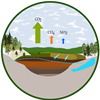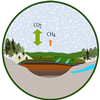Peatlands and climate
Numbers corresponds with numbers on the board
1.
There is no doubt that the Earth’s climate is changing. All data indicate that the source is human activity causing changes in the composition of the atmosphere – excessive emission of so-called greenhouse gases, primarily carbon dioxide (CO2). Even small amounts of CO2 in the atmosphere cause a phenomenon similar to greenhouse heating up – hence it is often called the greenhouse effect, and the gases that cause it – greenhouse gases.
The key to the carbon dioxide balance in the atmosphere are the so-called carbon circulation cycles. The basic cycle is that vegetation in the process of photosynthesis absorbs carbon dioxide and builds it in the form of organic compounds in its biomass. All living organisms in the processes of breathing (respiration) use organic compounds, which involves the release of carbon from them, emitted in the form of CO2 back to the atmosphere.
Peatlands are unique ecosystems in which part of the plant biomass in waterlogged, anaerobic conditions is transformed into peat, which means that the carbon contained in it is excluded from this cycle.
 | 2. Mires usually have their origin in former water basins, on which a moss-built carpet, including sphagnum encroaches gradually. The dead organic matter settles on the bottom of the basin gradually shallowing it. |
 | 3. Over time, the reservoir completely overgrows and dead plant debris form successive layers of peat. A constantly high groundwater level is just below the ground surface. |
 | 4. Subsequent layers of dead organic matter are deposited due to anaerobic conditions in the soil, which prevents degradation. Mire grows thicker as illustrated by red arrows. |
 | 5. Construction of drainage ditches leads to a lowering of the water surface and systematic erosion of peat soil. This causes the process to reverse – from the accumulation of carbon in peat soil to its emission due to decomposition. Agricultural use of such areas accelerates this process |
 | 6. Continued dehydration leads to a complete and irreversible loss of the mires’ ability to restore itself. Peat soil decomposes and mire overgrows with trees and bushes. In the case of peat exploitation and lack of water, peat vegetation disappears and desertification of such areas may occur. |
 | 7. Until the peatland has completely degraded, blockage of water outflow can, under favorable conditions, lead to the restoration of the peat-forming process. However, once degraded, the peatland will never return to its original, natural state. |
Photos
Mires in the boreal zone are very extensive, covering thousands of hectares.
Cracked peat on peat bogs in the Słowiński National Park as a result of peat exploitation and drainage.
Construction of wooden partitions on drainage ditches retains water in peatlands, and ditches overgrow over time, permanently improving water conditions.













